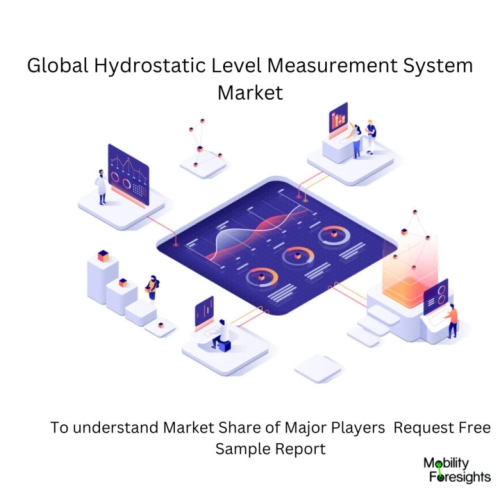
- Get in Touch with Us

Last Updated: Apr 25, 2025 | Study Period: 2024-2030
Using the hydrostatic pressure that a liquid exerts on its surface to determine the height of the liquid is known as hydrostatic level measurement.
The measured pressure exerted on the membrane increases as the liquid level rises. Gravity and the particular weight of the product inside the tank or vessel must be taken into consideration for a precise hydrostatic level measurement.
The usage of hydrostatic pressure transducers is favoured when the liquid's density is constant. Only liquids can be used with the hydrostatic level sensor. The fluids to be monitored can be directly measured by the hydrostatic level transmitters.
The measurement is based on the pressure inside the vessel as well as the density of the liquid being measured.To prevent deposits and debris, routine maintenance is necessary to clean the sensor membrane. Retention zones are avoided by level measurement solutions with flush diaphragms or hygienic connections.
Emptying the tank can be necessary for level transmitter repair work. This issue is avoided by level measurement systems that include ball valves. It is possible to remove the level sensors without draining the tank.
Gravity and the particular weight of the product inside the tank or vessel must be taken into consideration for a precise hydrostatic level measurement. The usage of hydrostatic pressure transducers is favoured when the liquid's density is constant.
To ensure an accurate measurement display over time, the sensor's measuring cell's scale and construction materials such stainless steel, hastelloy C, and monel must be adjusted.
The study of fluids that are not moving is called hydrostatics. By sensing the hydrostatic pressure in a virtually static liquid at a predetermined depth of submersion, a hydrostatic level sensor is a type of level probe used specifically for level monitoring.
A hydrostatic level sensor is a submersible pressure transmitter with a pressure diaphragm, the outer side of which is in contact with the liquid and which measures the static pressure of the liquid column above the transmitter.
The inner side of the diaphragm is vented to atmospheric pressure through a vent tube in the cable. This static pressure, which is used to determine the liquid level, is mostly brought on by the weight of the fluid resting on top of the transmitter.

The Global Hydrostatic Level Measurement System market accountedfor $XX Billion in 2022 and is anticipated to reach $XX Billion by 2030, registering a CAGR of XX% from 2024 to 2030.
The water and wastewater industry uses the hydrostatic level sensor most frequently as a specialised level monitoring sensor.Its straightforward operation and trustworthy measurement technology.
A hydrostatic level sensor is the go-to device whenever level needs to be measured, whether it's in a vented tank, vessel, lake, river, or reservoir. Most often, it is either submerged and let to drop to the bottom of the resource or suspended by a cable to the required measurement level.
A hydrostatic level sensor will always detect the pressure of the liquid untouched by such disturbances, regardless of the structure of the tank, basin, or natural geometry, or if it has any barriers, ledges, or complex shape. The hydrostatic level sensor automatically corrects for the atmosphere because it is often a gauge pressure sensor.
The pressure that is being measured, then, solely reflects the pressure that the liquid is experiencing due to its specific gravity and the vertical distance from the surface.
Consequently, the hydrostatic level sensor determines the distance from the measuring point to the surface level using the detected pressure in order to precisely measure the level of the liquid.
To account for either standard gravity or local gravity, a hydrostatic level sensor may be calibrated in metres of water column.
The temperature of the media may frequently be taken into consideration for very high precision level monitoring in order to take the temperature impacts on the specific gravity into account.
| Sl no | Topic |
| 1 | Market Segmentation |
| 2 | Scope of the report |
| 3 | Abbreviations |
| 4 | Research Methodology |
| 5 | Executive Summary |
| 6 | Introduction |
| 7 | Insights from Industry stakeholders |
| 8 | Cost breakdown of Product by sub-components and average profit margin |
| 9 | Disruptive innovation in the Industry |
| 10 | Technology trends in the Industry |
| 11 | Consumer trends in the industry |
| 12 | Recent Production Milestones |
| 13 | Component Manufacturing in US, EU and China |
| 14 | COVID-19 impact on overall market |
| 15 | COVID-19 impact on Production of components |
| 16 | COVID-19 impact on Point of sale |
| 17 | Market Segmentation, Dynamics and Forecast by Geography, 2024-2030 |
| 18 | Market Segmentation, Dynamics and Forecast by Product Type, 2024-2030 |
| 19 | Market Segmentation, Dynamics and Forecast by Application, 2024-2030 |
| 20 | Market Segmentation, Dynamics and Forecast by End use, 2024-2030 |
| 21 | Product installation rate by OEM, 2023 |
| 22 | Incline/Decline in Average B-2-B selling price in past 5 years |
| 23 | Competition from substitute products |
| 24 | Gross margin and average profitability of suppliers |
| 25 | New product development in past 12 months |
| 26 | M&A in past 12 months |
| 27 | Growth strategy of leading players |
| 28 | Market share of vendors, 2023 |
| 29 | Company Profiles |
| 30 | Unmet needs and opportunity for new suppliers |
| 31 | Conclusion |
| 32 | Appendix |